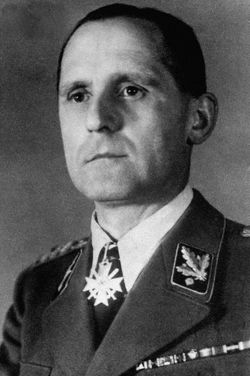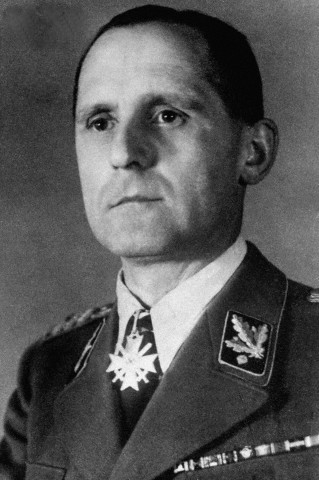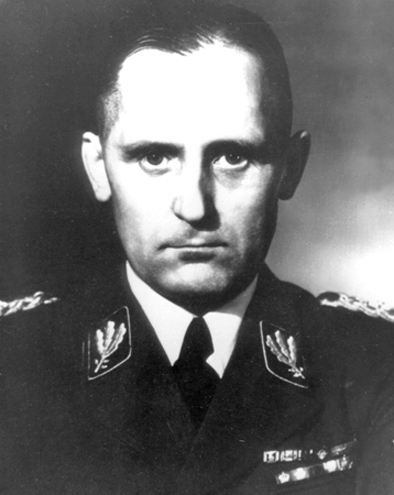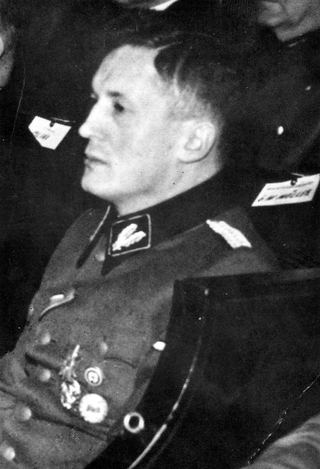Mueller was born in Munich to a working class family and was raised Catholic. When he reached military service age, he joined the German Army and learned to fly. He served as a spotter for an artillery regiment and was decorated numerous times for bravery. In 1919, he joined the Bavarian State Police. He witnessed the shooting of hostages in Munich by area communists and became a life-long hater of communism and its followers.
Mueller was diligent and professional in his police work and steadily promoted up to the Munich Political Police department. In that capacity, he became acquainted with Heinrich Himmler and Reinhard Heydrich, the leaders of the Nazi SS. Mueller was more a supporter of the Bavarian People's Party and not a supporter of the Nazis. On one occasion in 1933, during the Nazi putsch that deposed the Bavarian government of Minister-President Heinrich Held, Mueller had even recommended to his superiors to use force against the Nazis. Heydrich, who appreciated Meuller's professionalism and skill as a policeman, did not hold this fact against Mueller and may even have been responsible for Mueller's eventual absorption into the SS leadership (Mueller joined the SS in 1934) and by 1936 Mueller was the Gestapo's Operations Chief under Heydrich. Between his joining the SS in 1934 and by early 1936, the Communist resistance in Germany had all but been eliminated largely due to the works of Mueller's office. He would continue to work on infiltrating and arresting members of Communist organizations throughout his Gestapo career.
Mueller was also involved in the "Final Solution" of the "Jewish Question". Adolf Eichmann, was one of Mueller's subordinates and was tasked with the implementation of these policies. There is no doubt, as Eichmann's supervisor, Mueller was aware of the mass murders that occurred at the hands of the SS-Einsatzgrüppen units on the Eastern Front and at the various concentration camps around Europe.
One of his last tasks Mueller was involved in was the interrogation of SS General Hermann Fegelein in the cellar of the Church of the Trinity in Berlin. Fegelein was Himmler's liaison officer to Hitler and was attempting to desert Berlin when he was captured and brought back to Mueller. Fegelein was at first spared execution due to the intervention of Eva Braun who was Fegelein's sister-in-law. But after Hitler learned of Himmler's attempt to negotiate a surrender behind Hitler's back, Fegelein was shot. Hitler then committed suicide on April 30, 1945 and then on May 2, German Army General Helmuth Weidling surrendered Berlin. But Mueller had disappeared the day before.
Mueller was last seen in the Führerbunker in Berlin on May 1, 1945 and remains the most senior figure of the Nazi regime who was never captured or confirmed to have died. However, there is one account from a member of Himmler's staff that stated Mueller was with Himmler at Flensburg on May 11, 1945 and accompanied him and other SS officers in their unsuccessful attempt to escape capture by the Allies and reach Bavaria on foot with Mueller leaving Himmler at Meinstedt, Germany, after which Müller was not seen again. This report is not given a great deal of credence by most historians.
What happened to Heinrich Mueller is one of the most tantalizing mysteries of World war II and ranks close to the top of the list. It is believed by many serious researchers of Mueller that he was killed during the breakout from the Führerbunker at the Reichschancellery in Berlin. Walter Lüders, a former member of the Volksstürm, claimed he had been part of a burial unit which had found the body of an SS general in the garden of the Reich Chancellery, with the identity papers of Heinrich Mueller. Lüders reported they buried this body in a mass grave at the site of an old Jewish Cemetery on Grosse Hamburger Strasse. But doubt lingers and without DNA evidence, final determination of Mueller's fate will always be in question. What is known for sure, if he was still alive today, Mueller would be 113 years old (as of 2013) and without question, dead. But the need to know for historical purposes lingers after death.
(**NOTE** - Mueller was known as "Gestapo Mueller" to distinguish him from another SS general named Heinrich Mueller (the name was very common in Germany).
Mueller was born in Munich to a working class family and was raised Catholic. When he reached military service age, he joined the German Army and learned to fly. He served as a spotter for an artillery regiment and was decorated numerous times for bravery. In 1919, he joined the Bavarian State Police. He witnessed the shooting of hostages in Munich by area communists and became a life-long hater of communism and its followers.
Mueller was diligent and professional in his police work and steadily promoted up to the Munich Political Police department. In that capacity, he became acquainted with Heinrich Himmler and Reinhard Heydrich, the leaders of the Nazi SS. Mueller was more a supporter of the Bavarian People's Party and not a supporter of the Nazis. On one occasion in 1933, during the Nazi putsch that deposed the Bavarian government of Minister-President Heinrich Held, Mueller had even recommended to his superiors to use force against the Nazis. Heydrich, who appreciated Meuller's professionalism and skill as a policeman, did not hold this fact against Mueller and may even have been responsible for Mueller's eventual absorption into the SS leadership (Mueller joined the SS in 1934) and by 1936 Mueller was the Gestapo's Operations Chief under Heydrich. Between his joining the SS in 1934 and by early 1936, the Communist resistance in Germany had all but been eliminated largely due to the works of Mueller's office. He would continue to work on infiltrating and arresting members of Communist organizations throughout his Gestapo career.
Mueller was also involved in the "Final Solution" of the "Jewish Question". Adolf Eichmann, was one of Mueller's subordinates and was tasked with the implementation of these policies. There is no doubt, as Eichmann's supervisor, Mueller was aware of the mass murders that occurred at the hands of the SS-Einsatzgrüppen units on the Eastern Front and at the various concentration camps around Europe.
One of his last tasks Mueller was involved in was the interrogation of SS General Hermann Fegelein in the cellar of the Church of the Trinity in Berlin. Fegelein was Himmler's liaison officer to Hitler and was attempting to desert Berlin when he was captured and brought back to Mueller. Fegelein was at first spared execution due to the intervention of Eva Braun who was Fegelein's sister-in-law. But after Hitler learned of Himmler's attempt to negotiate a surrender behind Hitler's back, Fegelein was shot. Hitler then committed suicide on April 30, 1945 and then on May 2, German Army General Helmuth Weidling surrendered Berlin. But Mueller had disappeared the day before.
Mueller was last seen in the Führerbunker in Berlin on May 1, 1945 and remains the most senior figure of the Nazi regime who was never captured or confirmed to have died. However, there is one account from a member of Himmler's staff that stated Mueller was with Himmler at Flensburg on May 11, 1945 and accompanied him and other SS officers in their unsuccessful attempt to escape capture by the Allies and reach Bavaria on foot with Mueller leaving Himmler at Meinstedt, Germany, after which Müller was not seen again. This report is not given a great deal of credence by most historians.
What happened to Heinrich Mueller is one of the most tantalizing mysteries of World war II and ranks close to the top of the list. It is believed by many serious researchers of Mueller that he was killed during the breakout from the Führerbunker at the Reichschancellery in Berlin. Walter Lüders, a former member of the Volksstürm, claimed he had been part of a burial unit which had found the body of an SS general in the garden of the Reich Chancellery, with the identity papers of Heinrich Mueller. Lüders reported they buried this body in a mass grave at the site of an old Jewish Cemetery on Grosse Hamburger Strasse. But doubt lingers and without DNA evidence, final determination of Mueller's fate will always be in question. What is known for sure, if he was still alive today, Mueller would be 113 years old (as of 2013) and without question, dead. But the need to know for historical purposes lingers after death.
(**NOTE** - Mueller was known as "Gestapo Mueller" to distinguish him from another SS general named Heinrich Mueller (the name was very common in Germany).




